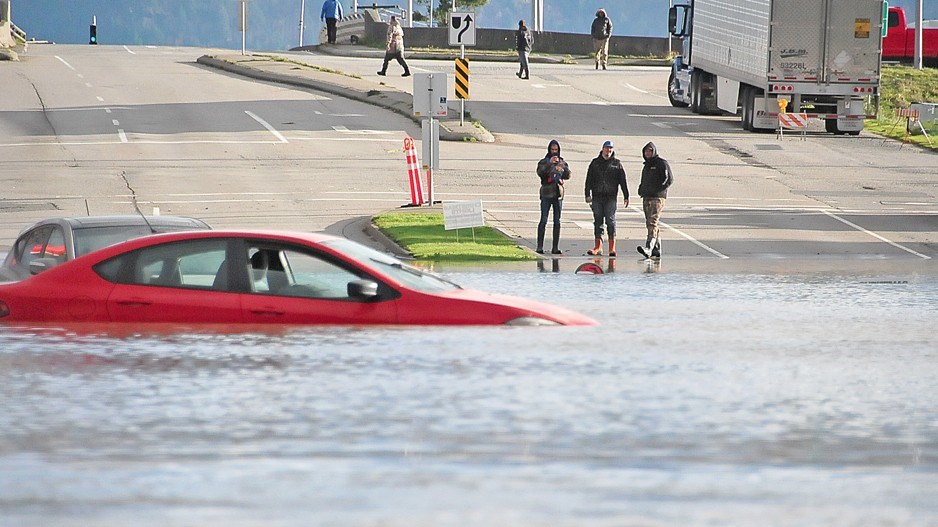As of mid-week last week, if you Google-mapped a route to Calgary from Vancouver, the only highway link was Highway 5 and 90 through Washington state. The only other way there was by airplane.
By now, one of the four highways that connect the Lower Mainland to the rest of B.C. – Highway 3 – could be reopened. That was the hope, last week, of B.C.’s Transportation Minister Rob Fleming, when he spoke to reporters the day after a three-day deluge crippled B.C.’s highway and railway networks.
But whether any traffic could get through Abbotsford was uncertain, as sections of the TransCanada Highway were passable only by boat.
And fixing a key artery – the Coquihalla Highway – was something that was expected to take weeks, if not months.
Although there had been sufficient warning of an approaching “atmospheric river” that dumped record amounts of rain on B.C., B.C. Public Safety Minister Mike Farnworth admitted last week that no one expected it to cause the kind of damage that it did.
“The impacts have been significantly greater than expected,” he said.
The Lower Mainland was cut off from the rest of B.C. for several days, as all highways that lead to it had sections that were washed out or severed by landslides and mudslides. Rail service was also halted, and the Trans Mountain pipeline, which provides oil for Burnaby’s refinery and refined fuels for the Lower Mainland had to be shut down as a precautionary measure.
Fiona Famulak, president of the BC Chamber of Commerce, said the damage to critical infrastructure like roads and railways, was alarming, and underscored the vulnerabilities of critical transportation infrastructure.
“The impact on the economy is going to be significant,” she said last week. “We need to be able to move, and it’s clear in the last 24 hours, we’ve lost that ability because major transportation routes have been cut off.”
Several communities in B.C. saw grocery stores emptied, due to severed supply chains and a sudden influx of evacuees from places like Merritt, Princeton and Abbotsford.
“We have supply chain issues that have been impacting us already because of the pandemic, and now we can’t get goods down to the Lower Mainland,” said Bridgitte Anderson, president of the Greater Vancouver Board of Trade (GVBOT).
Once the immediate crisis of getting roads and bridges repaired is over, Anderson said all levels of government will need to focus on improving critical infrastructure as part of climate change adaptation plans.
“I know that right now it really is a crisis management situation to deal with the urgent needs, but as the days go on, we need to also be more forward-looking in our response and think about how we can make our infrastructure more resilient and ensure that in the event of another disaster … that we can be sure that we are in better shape for when the next disaster happens.”
“We cannot afford to have our infrastructure out for any length of time, whether it’s road or rail,” Famulak said. “I think we need a really clear mitigation strategy, and part of that is strengthening the infrastructure so that when events like these happens it doesn’t have such a hard impact.
“Whether it’s flood, whether it’s fire, we need to be in a place where we can keep goods and services and people moving. We cannot afford to come to a standstill.”
One area of vulnerability revealed by recent flooding is Abbotsford, which lies along the Fraser River, and has long been prone to flooding. The TransCanada Highway passes through flood-prone areas, like Sumas Prairie – a former lake that was drained in the 1920s for agriculture and which last week turned back into a lake.
Abbotsford’s mayor urged residents of that area to evacuate over fears that the Barrowtown Pump Station – a critical piece of Abbotsford’s dyke and drainage system – was on the brink of failing.
Katerina Anastasiadis, executive director of the Abbotsford Chamber of Commerce, said the city has plans to improve its dyke and drainage systems to address flooding issues and hopes the federal government will now step up with the funding needed to accelerate those plans.
“This is something the city actually has been aware is a big risk for us – with our dyking systems – and something we worked with the federal government on to get infrastructure money for,” Anastasiadis said. “I’m hoping, with this incident, that they can see this is definitely a pressing issue for us.”
In its 2018 drainage master plan, the City of Abbotsford flags the dangers of localized flooding in the lowlands of Matsqui and Sumas Prairies, “undersized drainage infrastructure” in urban and rural areas, and “periodic road closures caused by flooding.”
The plan estimates the cost of improving the dyke and drainage system at $447 million over 25 years, about 77% of which is for improving the dyke system.
“The city is looking for more long-term partnership with the federal government for infrastructure funds to deal with dyking and drainage,” Anastasiadis said. “We need to be able to have reliable sources of funding to build this kind of critical infrastructure.”
As of Wednesday, the Train Mountain pipeline remained shut down, raising concerns of possible gasoline shortages, because the pipeline supplies oil for refining at the Parkland Fuels refinery in Burnaby and refined fuels from Alberta refineries. •




